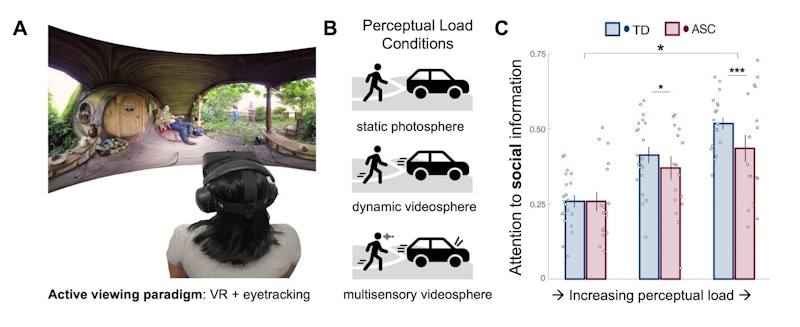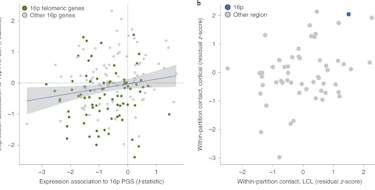Differences in social attention are thought to be hallmark characteristics of autism spectrum disorder (ASD). For example, individuals with ASD often direct less attention to socially relevant information in a scene compared to individuals without ASD (Chita-Tegmark, Rev. J. Autism. Dev. Disord., 2016; Frazier et al., J. Am. Acad. Child Adolesc. Psychiatry, 2017). Perplexingly, little is known about how these differences in social attention relate to non-social traits, such as the differences in processing sensory information (Robertson and Baron-Cohen, 2017, Nature Reviews Neuroscience). This is in part because research on social attention in autism is typically carried out using computer-based eye-tracking paradigms in highly controlled lab-based settings that lack many of the complex sensory features of real life. In a recent study supported in part by a SFARI Research Award, SFARI Investigator Caroline Robertson, AJ Haskins and colleagues sought to narrow the gap between lab-based eye-tracking paradigms and real-world environments in their investigation of the impact of perceptual load on social attention in ASD, using an innovative combination of immersive virtual reality, eye tracking and computational modeling (Haskins et al., Autism Res., 2022).
During real-world social interaction, attention to socially relevant information occurs in environments replete with complex multisensory perceptual features. Unlike traditional lab-based eye-tracking paradigms in which these features are absent and perceptual processing demands are relatively simple, the paradigm used by Robertson and her colleagues approximated real-world conditions. In their study, two groups of participants (ASD and neurotypical controls) viewed naturalistic, immersive scenes containing a wide variety of social information (such as individuals interacting) alongside non-social information (such as objects and buildings). Participants’ attention to socially relevant and irrelevant information in each scene was quantified while viewing under three different conditions of perceptual load: static (low perceptual load), dynamic, or multisensory (high perceptual load).
The study found that, in neurotypical controls, attention to social information increased as perceptual load increased, essentially doubling in the most complex multisensory condition. On the other hand, participants with ASD displayed reduced social attention. But, importantly, this difference between participants with ASD and controls only emerged in higher perceptual load conditions. In other words, reduced social attention was not found to be a static omnipresent characteristic of ASD; rather, it emerged and amplified in the presence of complex sensory processing demands. Based on these findings, Robertson and her colleagues suggest that social attention in ASD may be better explained by “social vulnerability” to the perceptual load of a complex multisensory environment. This vulnerability was also found to be specific for attention directed to socially relevant information, as there were no group differences found for attention to non-social information.
Overall, Robertson and her colleagues offer a more nuanced characterization of social attention difficulties in ASD. Their findings provide evidence for a direct link between social and sensory processing in ASD, suggesting that an individual’s sensory functioning causally influences social behavior in day-to-day perceptually demanding environments.

Reference(s)
Reduced social attention in autism is magnified by perceptual load in naturalistic environments.
Haskins A.J., Mentch J., Botch T.L., Garcia B.D., Burrows A.L., Robertson C.


